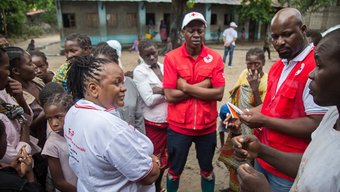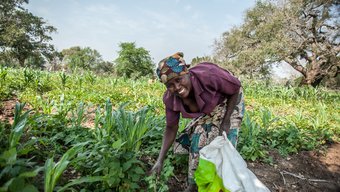Categories
The aftermath of anticipatory humanitarian actions taken for severe tropical storm ‘Chalane’ in Mozambique – was it worth it?
PART 1 (of 2) - The Narrative
Three days prior to the predicted landfall of tropical storm Chalane forecasted for the 30th of December 2020, the Mozambique Red Cross Society (CVM) with its main governmental counterparts, German Red Cross (GRC) and the IFRC decided to activate the Early Action Protocol (EAP) for cyclones, and to trigger the planned early action intervention in Buzi District, Sofala Province. Although wind speeds at landfall were predicted to be slightly less than the activation or trigger point as set out in the EAP, extensive consultations with the national meteorological institute (INAM) and Météo-France led to a conclusive ‘yes – we should’.
This blog is a short narrative about what followed as the first EAP activation in the Africa region. Part 2 of this blog - “The Data” - will be published in May.
What were the critical steps leading up to the activation?
The seasonal cyclone forecast issued by the regional specialized meteorological centre (RSMC) of the World Meteorological Organization (WMO), Météo-France, La Réunion island, had put Mozambican actors in disaster risk management on alert, as it indicated at least one system evolving into a Tropical Cyclone which would make landfall on the Mozambican coastline during the 2020-2021 cyclone season of the South-West Indian Ocean. CVM was monitoring cyclone activity in line with the ‘trigger’ or threshold chosen to activate the protocol: sustained wind speeds of 120 kilometres per hour at landfall, forecasted with a lead time of 72 hours prior to impact.
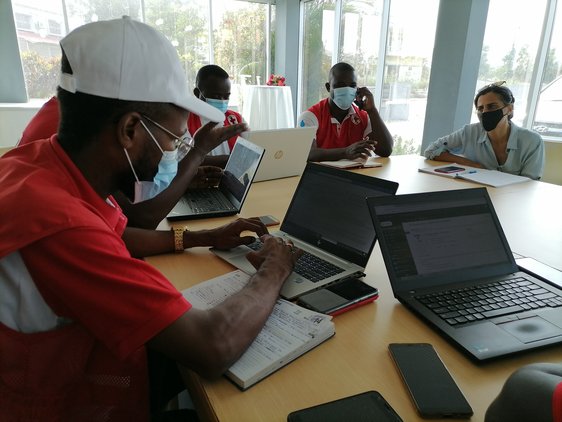
CVM’s FbF initiates the monitoring of international and national forecasts in daily coordination meetings and calls (Source: Mozambique Red Cross Society)
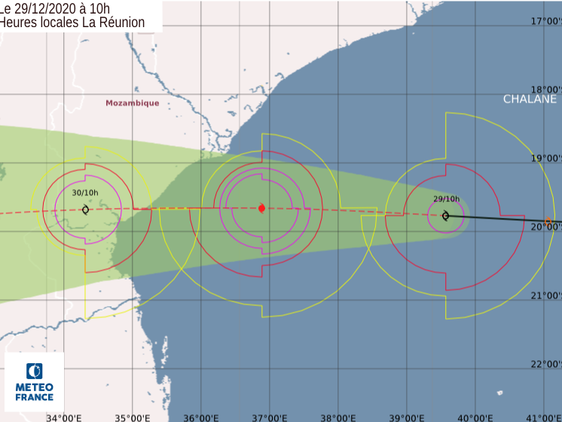
CVM’s FbF initiates the monitoring of international and national forecasts in daily coordination meetings and calls (Source: Mozambique Red Cross Society)

CVM’s FbF initiates the monitoring of international and national forecasts in daily coordination meetings and calls (Source: Mozambique Red Cross Society)
CVM’s FbF initiates the monitoring of international and national forecasts in daily coordination meetings and calls (Source: Mozambique Red Cross Society)
In Mozambique, the development of an early action protocol (EAP) within the Forecast-based financing (FbF) project was a process of one to two years, which was led by CVM in close collaboration with the national disaster management authority (INGD) and the national meteorological institute (INAM) as main partners, with technical support from the GRC. The protocol addresses cyclone impacts analyzed as historically having the most severe humanitarian footprint. Using a short time window of opportunity between the issuing of forecasts and the actual cyclone impact, a series of early actions are carried out by CVM and partners. This includes the distribution of shelter kits, reinforcement of vulnerable houses and school buildings, as well as the distribution of water purification tablets and jerry cans.
The year leading up to the 2020-2021 cyclone season was struck by Covid-19, which put many of the annual readiness activities, such as the capacitation of provincial Red Cross branches and their volunteers in early action implementation, on hold. This challenged CVM to conduct short-term operational readiness activities at the start of the season, when Mozambique’s State of Emergency ended and restrictions were eased. Just weeks prior to the Chalane activation, CVM was able to conduct a large-scale simulation exercise, which played out a full EAP activation scenario.
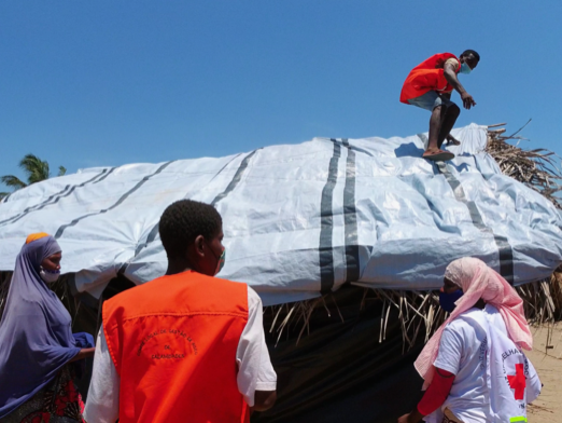
CVM conducts a large-scale EAP activation simulation exercise in the Province of Nampula (Source: Mozambique Red Cross Society)
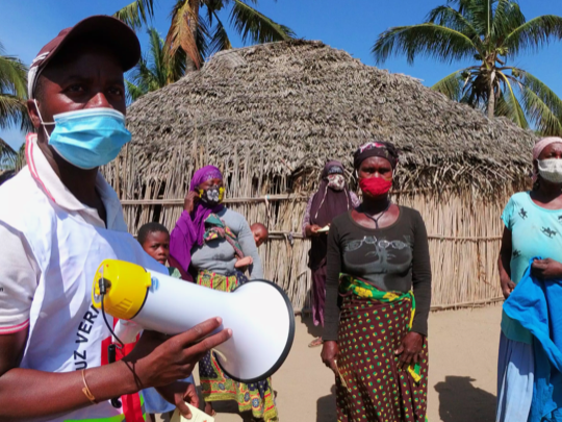
CVM conducts a large-scale EAP activation simulation exercise in the Province of Nampula (Source: Mozambique Red Cross Society)

CVM conducts a large-scale EAP activation simulation exercise in the Province of Nampula (Source: Mozambique Red Cross Society)
CVM conducts a large-scale EAP activation simulation exercise in the Province of Nampula (Source: Mozambique Red Cross Society)
Covid-19 tasked the FbF team to adapt the early action procedures to the new normal and ensure an activation could be carried out in a safe manner. This meant pre-positioning Covid-19 protection kits for CVM staff and volunteers to be involved in an EAP activation, as well as for the 1500 target households to be reached. It also meant understanding that we were now operating in a context of compounding risk, of heightened vulnerability in line with direct and secondary, socio-economic impacts of the pandemic.
How did the EAP activation play out?
On alert since the first notification of tropical storm Chalane forming on the 21st of December 2020, the CVM core FbF team monitored the evolution of the system in daily coordination calls, interrupting the annual festive season and institutional holidays. On the day of the 72 hour lead time mark, December 27th, all involved stakeholders were faced with challenging joint decision making. The forecasts indicated that Chalane would make landfall with an intensity just under the defined trigger (120km/h), forecasting maximum sustained wind speeds of 117 km/h. INAM warned that favourable conditions in the Mozambique Channel would lead to a rapid intensification of Chalane during the last days and hours leading up to landfall with a likelihood of exceeding the trigger in reality, which the models were not reflecting, as had previously been the case with past cyclone events.
In addition, the different forecast sources had started to unanimously foresee a cyclone trajectory with the most severe impact around the city of Beira, Sofala province, a region still recovering and reconstructing from the devastating impact of Tropical Cyclone Idai, which had struck Mozambique in 2019. Compounding the high levels of vulnerability, the Covid-19 pandemic and related socio-economic impact had created an all the more complex scenario of risk. Jointly, the decision was made to activate and to act - early.
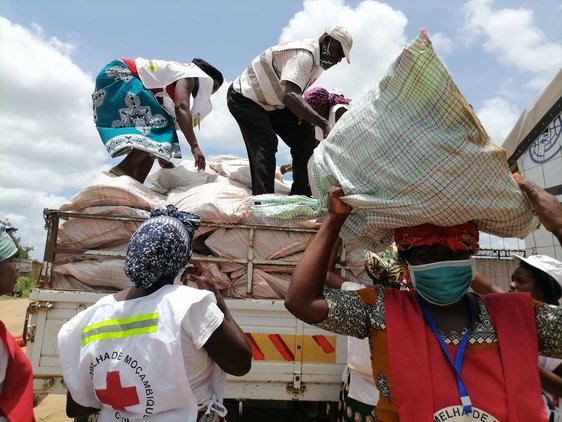
Unloading of the WASH and shelter kits in Buzi district and the dissemination of early warnings in the target communities (Source: Mozambique Red Cross Society)
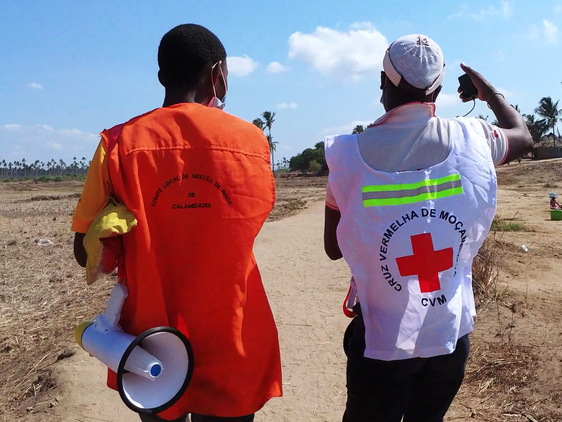
Unloading of the WASH and shelter kits in Buzi district and the dissemination of early warnings in the target communities (Source: Mozambique Red Cross Society)

Unloading of the WASH and shelter kits in Buzi district and the dissemination of early warnings in the target communities (Source: Mozambique Red Cross Society)
Unloading of the WASH and shelter kits in Buzi district and the dissemination of early warnings in the target communities (Source: Mozambique Red Cross Society)
CVM sent two anticipation teams to the area expected to be impacted by Chalane. One of the teams, in collaboration with the disaster management authority INGD, ensured the coordination with and involvement of district authorities and community leaders and supported the activation of Red Cross volunteers through the CVM provincial delegation. The other team coordinated the logistics around the activation, focusing on the mobilization and loading of trucks, dispatching the prepositioned stock to Buzi district from the central warehouse in Caia and sending the items on the 450-kilometer, bumpy journey to the distribution point.
With the support of 50 Red Cross volunteers, the deployed anticipation team distributed shelter and WASH kits, demonstrated the technique for the reinforcement of houses, correct use of water purification tablets and distributed early warning messages.
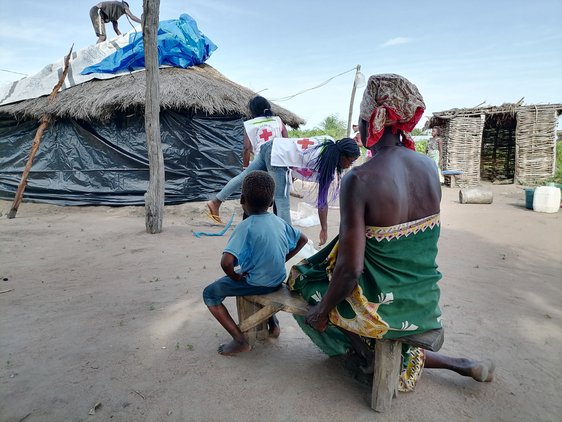
Red Cross volunteers assist vulnerable households in the reinforcement of their houses (Source: Mozambique Red Cross Society)
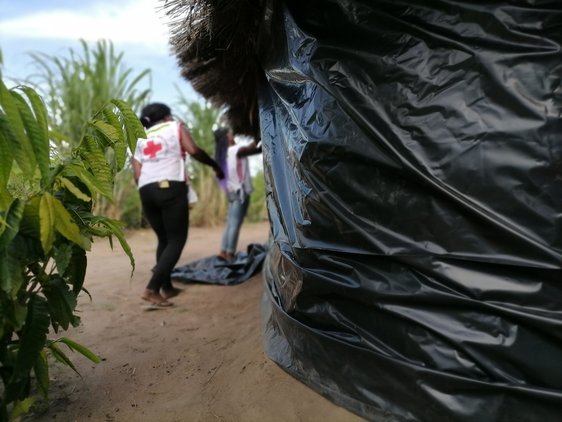
Red Cross volunteers assist vulnerable households in the reinforcement of their houses (Source: Mozambique Red Cross Society)

Red Cross volunteers assist vulnerable households in the reinforcement of their houses (Source: Mozambique Red Cross Society)
Red Cross volunteers assist vulnerable households in the reinforcement of their houses (Source: Mozambique Red Cross Society)
What was the actual observed impact?
A first impact assessment by the deployed FbF team after Chalane’s impact revealed less impact than forecasted, yet houses had still suffered damage, and families had evacuated to safe places. The deployed team supported the communities in the repair of houses, as well as the construction of shelter for families displaced through the impact. Just weeks after Chalane, Tropical Cyclone Eloise took on a trajectory towards Beira, putting the same districts at severe risk of impact. The 1500 households reached during the Chalane activation were warned by Red Cross volunteers on the approaching event. They were able to replicate the early actions and reinforce their houses once more, as well as treat their water supplies with water purification prior and after Eloise’s impact.
What did we learn from an operational perspective?
A few months down the line, having gone through the process of post-activation evaluation and extensive discussions around lessons learned, we pause to reflect once more on this first EAP activation in the Africa region. Coordination between the different FbF stakeholders showed to be one of the main strengths of the FbF system in Mozambique. The close working relationship and short lines of communication and decision making proved to be key for a successful activation under time pressure. Also, CVM was perceived in a lead role in the provision of accurate information around the forecasted impact during the national and provincial coordination meetings leading up to the event, which created great trust in and visibility of the central responsibility of CVM as an anticipation actor in Mozambique.
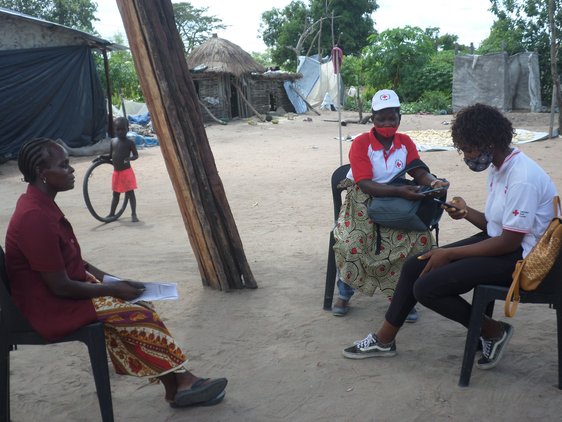
Red Cross volunteers conduct post-trigger household surveys in Buzi district and CVM maps out the activation timeline as part of the lessons learned workshop (Source: Mozambique Red Cross Society)
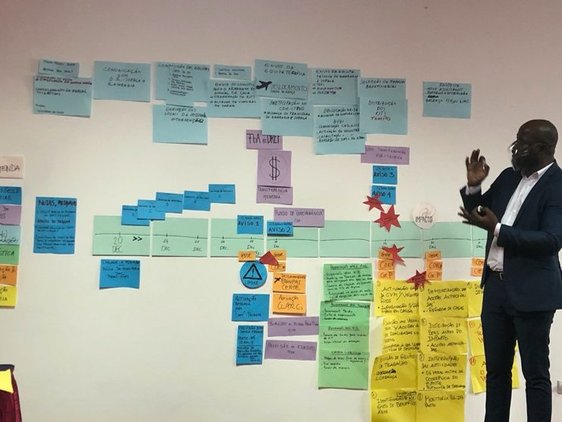
Red Cross volunteers conduct post-trigger household surveys in Buzi district and CVM maps out the activation timeline as part of the lessons learned workshop (Source: Mozambique Red Cross Society)

Red Cross volunteers conduct post-trigger household surveys in Buzi district and CVM maps out the activation timeline as part of the lessons learned workshop (Source: Mozambique Red Cross Society)
Red Cross volunteers conduct post-trigger household surveys in Buzi district and CVM maps out the activation timeline as part of the lessons learned workshop (Source: Mozambique Red Cross Society)
We identified various points with room for improvement to enable a more robust FbF system in Mozambique became apparent, as well. The Cyclone EAP requires additional operational details that clearly outline associated logistical, financial and administrative procedures to allow for quicker action in the short time frame available. An EAP development process can be a complex, analytical process, building the scientific evidence for the robustness of the trigger methodology and theory of change of the selected early actions, whereas operational specifics can often take a backseat. For Mozambique, this led to the logistical capacity of CVM being challenged with an operationally complex supply chain and time intensive early actions in a 72-hours-short time window for action. As CVM embarks on the EAP revision process, the interplay between lead time, cyclone forecast accuracy vs. uncertainty and early action operations will need to be reassessed.
This builds the case for understanding an EAP as a living document, which is adapted based on ongoing learnings and evolves along with wider national society capacity built over the protocol’s lifetime. Unanimously, FbF stakeholders in Mozambique agree that the Chalane activation allowed involved actors to see FbF in full action, producing key learnings that will feed the EAP revision process towards building a more robust FbF system for Mozambique.
So, was it worth it?
The consensus decision to activate the Cyclone EAP prior to Chalane was based on forecast information, as well as expert judgement at the 72-hours lead time mark for triggering, which indicated a high likelihood of the cyclone trigger to be exceeded during the hours leading up to landfall. The decision was also based on a joint context analysis taking into consideration heightened levels of vulnerability in a new reality of the Covid-19 pandemic, as well as compounding vulnerabilities in communities still undergoing the recovery and reconstruction process post-Idai 2019 forecasted to be exposed to the impact of Chalane. The Chalane activation reached 1500 households with shelter and WASH kits, which allowed families to buffer both Chalane’s and Eloise’s impact, as well as raised wider awareness around short-term preparedness measures leading up to cyclone impact. The activation put the national FbF actor constellation to an operational stress test and showed that coordination works effectively and builds on strong relationships of trust. The activation also crystalised the main operational challenges of a full early action operation down to the most urgent needs for the revision of the FbF methodology for cyclones and will now help us mature it. So, yes, we believe it was worth it, we believe it was a necessary step in the further evolution of FbF in Mozambique, in generating learnings and continuously working towards the best FbF-fit for the specific national context and hazard risk we built it for.
PART 2 of this Blog (to be published in May) - “The Data” - will let the data from the post-trigger evaluation data collection speak.
This blog was written by Jurg Wilbrink, DRR & FbF Advisor Southern Africa, IFRC and Anna Lena Huhn, Regional FbF Delegate Southern Africa, GRC.

